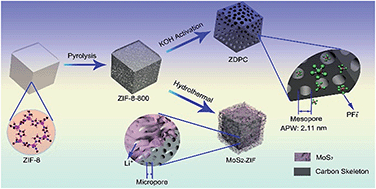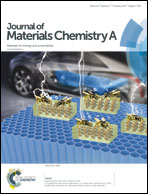Engineering metal organic framework derived 3D nanostructures for high performance hybrid supercapacitors†
Abstract
Metal–organic frameworks (MOFs) have demonstrated great promise as a new platform for the synthesis of porous electrode materials for energy storage. Research effort on MOFs and MOF derived nanostructures has focused mainly on tuning the chemical composition at the molecular level and developing highly porous frameworks in which enhancing the capacity and reducing the transport path of ions are favorable. Here we report an approach using the MOF (polyhedral ZIF-8) as a novel precursor to synthesize two electrode materials with different energy-storage mechanisms: the capacitor-like porous carbon polyhedra and the battery-like MoS2–ZIF composite. The porous carbon polyhedra have a continuous 3D porous network with an extremely high surface area of 3680.6 m2 g−1 and a well-controlled pore size distribution, and the MoS2–ZIF composite shows a three-dimensional (3D) nanostructure with an open framework. Furthermore, a novel hybrid supercapacitor is fabricated by employing these two 3D nanostructured MOF-derived electrode materials, which shows the best properties among the current hybrid supercapacitors with respect to energy, power and cycling life. The presented strategy for the controlled design and synthesis of 3D MOF-derived nanostructures provides prospects in developing high-performance active materials in advanced energy storage devices.



 Please wait while we load your content...
Please wait while we load your content...